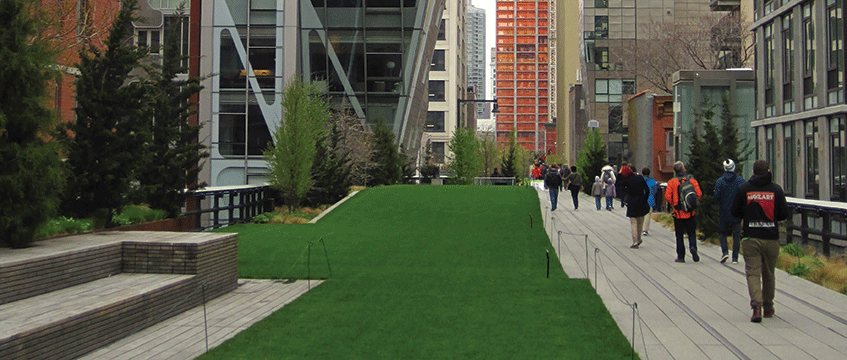My Zoom call with Louise Wyman, the new strategic director of growth and development for Manchester City Council, offers a peek into her light and airy home. There’s a potted plant sprouting into view. And I can see a painting of what looks like a swimming pool.
Throughout the interview, it becomes clear that earth and water sit very close to Wyman’s heart. In fact, they are key to her plans for the future of Manchester; plans that she is mapping out in unprecedented circumstances.
In June, Wyman took over from Eddie Smith, who reigned over the city’s regeneration for 20 years. It means Wyman has big shoes to fill in the most challenging of times – she will be responsible for leading Manchester out of lockdown and overseeing its recovery and regeneration post-pandemic. Council leader Sir Richard Leese has described the job as “one of the most demanding roles in local government”.
But Wyman has impressive experience under her belt. She spent some 12 years at the Homes & Communities Agency, three years at Homes England as its director of strategy and engagement, played a central role in the delivery of London’s 2012 Olympic Park, and most recently was director of design and development for the West Midlands Combined Authority before leaving for Manchester.
So how will she guide the city into its post-Covid future?
Manchester: the new New York
Understanding Wyman’s blueprint for Manchester requires an understanding of the early stages of her career in real estate. She studied in the US, learning about the design and construction of American cities for a masters degree in landscape architecture at Harvard. This experience has clearly had a lasting influence on her design inspirations.
“One thing which has really struck me [since] is that landscape architects in particular are doing a lot with waterfront restoration in cities,” she says.
She points to San Francisco as a city that has “transformed its relationship with water”, and says New York has undertaken “really impressive work” around water attenuation measures after Hurricane Sandy caused a flood on Wall Street in 2012.
The relationship between cities and their waterways fascinates Wyman, and she believes Manchester could undergo its very own transformation in this respect. At a time when outdoor space in cities is in greater demand, an opportunity presents itself for Manchester to breathe new life into its underappreciated rivers and canals.
“You don’t think of water when you go to Manchester, you don’t really see water,” Wyman says. “And yet it’s there. The boundary between Manchester and Salford is water but you go over a bridge and you don’t get the feeling of what’s beneath.”
Wyman says the council has been looking at developing proposals for a “blue line”, which would reconnect the city’s canal and river networks and allow people to walk around it in a loop. “We’re taking inspiration from the High Line in New York,” Wyman says of the elevated park on a disused railway track in Manhattan.
This blue line proposal could see the council connect its canal infrastructure, old rail lines and viaducts with pathways. Like New York’s High Line (pictured), some parts could be elevated, while others could be right by the water’s edge. Among the sites that could be included is the £110m Factory arts centre at the heart of Allied London’s St John’s project in the Spinningfields Quarter.

Flexibility on foot
The coronavirus lockdown and the limited outdoor ventures that are now allowed have shone a spotlight on the availability of public realm in cities.
It has also sparked Manchester’s movement towards pedestrianising areas of the city, allowing businesses to operate outside while maintaining social distancing in an attempt to stimulate the local economy.
Thomas Street, in the Northern Quarter, was pedestrianised, and areas in Deansgate between King Street West and Blackfriars Street were partially closed to free up space for events and markets.
“We’re going to need space where our communities can be outside more easily, both for recreational [purposes], but also for transacting,” Wyman says. She wants the city’s outside spaces to operate more like “urban living rooms” and for businesses to have greater flexibility to operate outside more.
Could this mark a move towards permanently pedestrianising some parts of the city?
“It’s something we’re looking at,” Wyman says, pointing to the Northern Quarter and Great Ancoats as areas where this could work well. “We have a whole city centre team that has plans to increase pedestrianisation of core areas and to increase ease of movement – particularly on foot.”
A tech destination
Coronavirus has underscored just how valuable technology is when it comes to keeping the economy moving and businesses operating.
And the tech sector will continue to play a critical role in Manchester’s post-Covid journey, Wyman says. The sector is a key part of the city’s economic recovery plan, and the council is working with it to understand how the local authority can encourage the sector’s growth in the city and the Greater Manchester area.
Wyman says there is a “huge amount of interest” in Manchester as an emerging location for data centres. “If you speak to the agents in the city, there’s probably more interest now as investors look to find cities outside of London in which to invest in real estate, and data centres go with the tech story,” she adds.
Data matters, Wyman says, and being able to access it matters even more for businesses that are operating remotely. Data centres, therefore, are increasingly important for cities like Manchester, allowing companies to operate smoothly in the virtual world and helping to attract data-hungry companies into the city.
“We have a growing film sector and the creative arts has always been really strong in and around Manchester,” she says. “They need big data to produce films, and the financial markets need it as well for the systems they need to run. So there lies the synergy between data availability and businesses that will want to set up here in the future.”
Green challenges
But a growth in data centres comes with a green price tag. They use a lot of energy, and the world’s biggest may require more than 100 megawatts of power to operate – enough to power 80,000 homes, according to thinktank Energy Innovation. McKinsey research also shows that data centres have been known to emit a massive 80 megatonnes of CO2 a year.
Could growth in this sector conflict with Manchester’s aims to hit net zero carbon by 2038, and GMCA’s target to hit net zero by 2030? It is a tension that Wyman acknowledges, and she says the city is working with the energy sector to solve the conundrum.
“If we want the businesses, we need the data provision, and if you’re energy-hungry then we need to look at the energy provision, so in my mind you go back to energy generation,” Wyman says. “We’re working with the energy providers and utility companies – and some of the best tech, in terms of net-zero carbon pathways, will come from the energy sector itself. There’s a lot of competitiveness there, and that we need to balance with the data centre piece.”
It is not just the energy sector that has a crucial role in mapping out Manchester’s pathway to net zero. Property does too, and Wyman says the council is considering setting green targets for developers on its public-private partnership projects.
Wyman wants to improve these relationships and better understand “what we want to get out of the partnerships”.
“In a partnership arrangement, [we] spend time asking what matters [to property companies], what matters to us as the public sector and how we drive that together,” she says. “Having clear ambitions, having targets that we can all work towards, is part of that.”
The council is also investigating retrofitting homes to make them energy efficient. Such a programme will need “a lot of investment from sources other than the council”, Wyman says.
“We will need to bring partners with us, and we’re having those conversations with a lot of the development community who are also committed to zero carbon, as well as the energy generation sector,” she says.
Ambitions and accountability
As the conversation draws to a close, Wyman says she wants to be held accountable for the decisions she takes in guiding Manchester out of the coronavirus crisis. “You have ambitions, but you then quite quickly need to be tested on them,” she says, adding that she wants to be open in telling the story about Manchester’s upcoming changes.
Before we sign off, I ask about that painting that sits behind her. It turns out that it’s a painting of San Francisco’s waterfront in the 1900s, complete with a canopy extending over the sea for people visiting the waterfront. “It’s the [Pacific] ocean, which comes under a swimming pool roof, in simple terms,” Wyman says.
One wonders what inspiration Wyman will take from that and America’s other waterfront cities that could be given its own twist in Manchester.
To send feedback, e-mail lucy.alderson@egi.co.uk or tweet @LucyAJourno or @estatesgazette











